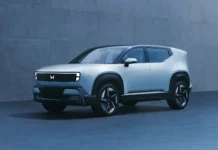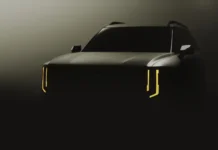The Kia Soul in all of its trim levels has been a raging success since its introduction a few years ago, promoted by a loveable group of hip hamsters. The Kia Soul has steadily evolved each year, and so has the hamster gang, growing more sophisticated with each year of production. Now the hamsters have progressed into engineering and scientific types to promote the new, 2015 Kia Soul EV – a totally electric vehicle, with a range of up to 100 miles (depending of course upon terrain, road conditions and driving style). The Kia Soul EV actually boasts a best-in-class EPA-estimated range of 93 miles and MPGe4 of 92 miles on the highway and 120 miles in the city (105 miles combined).
| STATS | Starting Retail Price | As Tested Price | HP / Lb-Ft |
| 2015 Kia Soul EV+ | $35.700. | $36,500. (not including federal tax rebate of $7,500). | 109 / 210 |
| EPA Rating | As Tested MPGe | ||
| Rating: BUY IT! | 120 MPGe city / 92 MPGe highway / 105 MPGe | Not tested |
The force that moves the new Soul EV comes from a front mounted AC syncronous permanent magnet electric, liquid-cooled motor with a Lithium-Ion Polymer Battery Pack – 27kWh energy/90kW power/360 volts/75 amp hour/ hours-kg 200/volume=8.5 cu. ft. The 12V battery capacity is 45 AH. Included is an on board chgharger-6.6kW with level 1 and 2 ports, plus a DC fast Charge port. The efficient electric motor delivers 109 horsepower along with 210 pound feet of torque. The energy produced drives the front wheels through a one-speed gear reduction with an 8.206 ratio. The 0-60 mph time is 11.2 seconds – not drag strip fast overall mind you, but plenty quick off-the line. There are two gear shift modes D and B (Drive and accelerated regen Braking)

Stopping duty is handled by Active Hydraulic boost four-wheel discs (vented front/solid rear) with electric motor polarity reversed / 9%-12%kinetic energy recovery regenerative braking
At first glance, this new Kia Soul EV looks very much like the rest of the Soul lineup, but there are significant features in its styling execution that differentiate it from the rest of the pack, such as the smooth frontal appearance with no grille, but a cleverly hidden charge port, special front quarter “Eco Electric” and rear gate badging; the obvious lack of an exhaust pipe; and uniquely specific, slotted disc alloy wheels shod by special, super, low rolling resistance tires; all adding to the EV’s individuality. In other words, the Kia Soul EV has managed to retain its funky, hip, loveable design form. From its “floating” roof to the greenhouse that makes appear to be wearing wraparound sunglasses, the EV’s look is inspired by the 2012 Kia Track’ster concept, retaining the iconic square-shouldered broad stance of the original Soul. The Kia Soul EV will be offered initially in four color choices: Caribbean Blue lower body with Clear White roof, Shadow Black lower body with Inferno Red roof, Titanium Gray and Clear White. This signature two-tone paint theme is exclusive to the EV. The EV-exclusive front fascia includes a larger grille area to accommodate the charging ports, with color accent trim in the front and rear fascias.

There are actually two levels of trim – the Base Soul EV and a more upscale Kia Soul EV+ that adds: aero windshield wipers; projection fog lights; power folding outside mirrors; elctrochromatic rear view mirror; a luggage net; a cargo screen; a luggage compartment 12V power outlet; leather seat trim; 3 level heated and ventilated front seats; 2 level heated rear outboard seats; leatherette cluster housing and center door trim; a passenger seat side tray; and a park assist system with front and rear sensors. Pricing for the Soul EV will range from $33,700 for the Base model to $35,700 for the Soul EV+ (Plus), (neither price includes the federal tax rebate of $7,500). The expected introductory lease price will be $249 per month. The Kia Soul EV will go on sale initially only in California, with other states to follow soon after.
Thanks to the battery design and under floor positioning, there is minimal intrusion into the cabin, with only a slight decrease of 3.1-inches in rear legroom, with the Soul EV still offering more rear seat legroom than other key EV competitors. Rear shoulder and hip room are unchanged from the gasoline-powered Soul, making the Soul EV one of the roomiest in its segment. Rear cargo space of 18.8 cu.-ft. (with rear seats up) also remains unchanged from the internal combustion engine Soul, and the under-cargo tray provides convenient storage for the standard 120v portable charger.

Standard Soul EV amenities include Navigation with an eight-inch screen, a 6.6kW on-board charger, CHAdeMO DC fast charge port, Rear Camera Display, Bluetooth hands free operation, power windows, power driver’s seat, cruise control, and an exclusive HVAC system designed to extend driving range by minimizing energy draw.
With air conditioning being one of the largest energy drains in any electric vehicle, the Soul EV uses four key technologies to maximize HVAC efficiency: a standard heat pump, individual ventilation, scheduled ventilation, and air intake control. The heat pump efficiently combines the A/C and heater into one system while greatly reducing energy consumption, also utilizing waste heat from the Soul EV’s electrical systems to help heat the cabin. Individual ventilation allows selection of “Driver Only,” which stops airflow to the passenger side front dash and floor vents and the floor vents for the rear passenger compartment, focusing airflow on the driver and reducing the amount of energy needed to reach a comfortable interior temperature.

To deal with range anxiety and charging options, the Soul EV makes charging easy by plugging into any standard 120v outlet or a conventional 240v EV charger. Two charging ports are standard, including a SAE J1772 port for Level 1 and Level 2 AC, and a CHAdeMo DC fast-charging port (480v). All charging ports reside behind a sliding door located in the front grille; the dual ports offer flexibility, increasing the Soul EV’s extended travel appeal, making it more convenient to charge at home or on the road. Recharging times vary from 24 hours for a fully depleted battery using a standard 120v outlet and from four to five hours when plugged into a 240v outlet. An 80-percent charge can be achieved from empty in as little as 33 minutes with a 50 kW-output DC fast charger. Kia partners with three different charger providers – Bosch, Leviton and AeroVironment™ – giving Soul EV buyers the option of selecting the unit best suited to their in-home needs. Additionally, the 17 Kia retailers participating in the first wave of the Soul EV launch will each be equipped with multiple Level 2 chargers and a DC fast charger, bringing California’s current DC fast charging network to a total of 215.

The Soul EV is distinguished by Kia’s most extensive use of bio-based materials and has received the Underwriters Laboratory’s first ever automotive environmental claim validation for its 52.7 lbs. of bio-based organic content in interior plastic. Foremost is the use of BTX-free paint on the audio system surround, vent bezel and the floor console. Bio-based plastics derived from cellulose and sugar cane are found throughout the cabin, including the door panels, headliner, seat trim, roof pillars and carpeting. 19 different interior parts in all, utilize organic, bio-based materials.
My test 2015 Kia Soul EV + sported the Clear White over Caribbean Blue exterior with a Gray leather appointed leather interior featuring Blue piping. The MSRP was set at $35,700 before taking into account a $7,500 federal tax credit and other available state and local incentives.
SUMMARY: The 2015 Kia Soul EV+ enters a playing field with several competitors that all fit into a close proximity of range capability and price, but it certainly seems capable of competing admirably with its adversaries.

The Kia Soul EV has the advantage of being one of the more visually appealing electric vehicles in today’s marketplace. Its range is acceptable and the varied charging options are competitive, as is its pricing structure.
In terms of its performance, it delivers rapid acceleration and responsive braking. The ride quality is comfortable, and the handling characteristics are on the sporty side of the equation. The Soul EV also scores well in the safety, connectivity and entertainment departments.

In the final analysis, the 2015 Kia Soul EV+ is a totally satisfying and pleasing electric vehicle that comes in a reasonably affordable package considering its content level of features and equipment. In its size and market category, it may well be the best choice overall. Obviously visual appeal is perhaps one of the most important factors in electric vehicle selection, and the Kia Soul EV+ might possibly have the edge. What will the hamsters come up with next?
On the TFLcar scale of:
- Buy it!
- Lease it!
- Rent it!
- … or Forget it!
I give the 2015 Kia Soul EV+ a Buy It! for an Fun, efficient, pure electric vehicle.
SPECIFICATIONS: 2015 Kia Soul EV +
Base Price: $35,700.
Price as Tested: $36,500. (not including federal tax rebate of $7,500).
Engine Type and Size: AC syncronous permanent magnet, liquid-cooled electric motor with Lithium-Ion Polymer Battery Pack – 27kWh energy/90kW power/360 volts/75 amp hour/ hours-kg 200/volume=8.5 cu.ft./12V battery capacity 45 AH.
On board chgharger-6.6kW with level 1 and 2 ports, plus DC fast Charge port
Horsepower (bhp): 109
Torque (ft./ lbs.): 210
Transmission: 1-speed gear reduction with 8.206 ratio.
Drive Train: Front motor / Front-wheel Drive.
Suspension: Front – MacPherson strut type, coil spring.
Rear – Coupled torsion beam axle.
Brakes: Active Hydraulic boost four-wheel discs (vented front/solid rear) with electric motor polarity reversed / 9%-12%kinetic energy recovery regenerative braking and electronic parking brake. Included are ABS, BAS, ESC, VSM, TPMS and Hill Start Assist.
Tires: Nexen Blue EV 205/60 R16 super low-rolling resistance, mounted on 5-slotted disc aluminum alloy wheels.
Wheelbase: 101.2 inches
Length Overall: 163.0 inches
Width: 70.9 inches
Height: 63.0 inches
Curb Weight: 3,289 lbs.
Turning Circle: 34.8 ft.
Fuel Capacity: No fuel – battery electric powered.
EPA Mileage Estimates: 120 MPGe city / 92 MPGe highway / 105 MPGe
combined. Estimated range – 93 miles.
Drag Coefficient: Not listed.
0 – 60 mph: 11.2 seconds.
Review by Arv Voss, Auto Impressions
 Arv Voss is a Northern California based freelance motoring Journalist who contributes to a number of national and international media outlets, reviewing cars, trucks SUVs, and motorcycles.
Arv Voss is a Northern California based freelance motoring Journalist who contributes to a number of national and international media outlets, reviewing cars, trucks SUVs, and motorcycles.

























